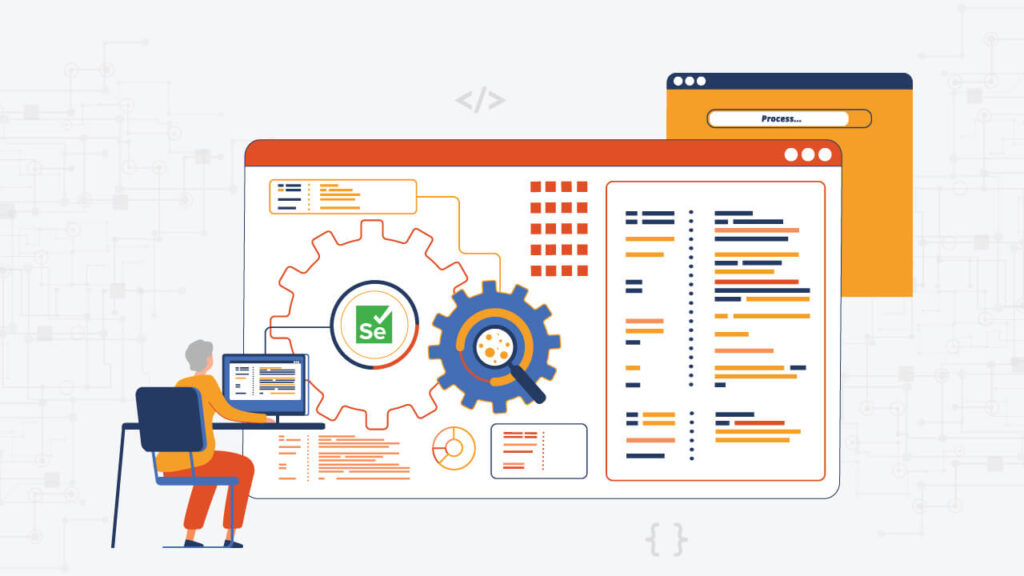Test automation with Selenium and Python has gained immense popularity in recent years due to its ability to speed up the testing process, reduce manual effort, and improve the accuracy of test results.
However, effective test automation requires more than just a basic knowledge of Selenium and Python. In this article, we will discuss five tips that can help you achieve effective test automation with Selenium and Python.
Page Contents
1. Design a Robust Test Framework
A robust test framework is essential for successful test automation with Selenium and Python. A test framework is a set of guidelines and rules that govern the way you write and execute test cases. It provides a systematic approach to testing and helps ensure that your tests are reliable and maintainable. A good test framework should be easy to use, maintain, and extend. Here are some tips for designing a robust test framework:
- Define Test Scope: The first step in designing a test framework is to define the scope of your tests. This includes identifying the functionalities to be tested, the platforms to be tested on, and the types of tests to be conducted.
- Identify Test Tools: Once you have defined the scope of your tests, the next step is to identify the test tools you will need to automate your tests. Selenium is a popular test automation tool for web applications, and Python is a programming language that can be used for test automation. Other tools that can be used in conjunction with Selenium and Python include test frameworks like PyTest and Robot Framework, CI/CD tools like Jenkins and GitLab, and cloud-based testing platforms.
- Create a Test Plan: A test plan is a document that outlines the testing strategy, the testing approach, and the test schedule. It should also include details on the test environment, the test data, and the expected results. A well-designed test plan can help ensure that your tests are thorough and efficient.
- Write Test Cases: Test cases are the building blocks of your test framework. They define the specific steps that need to be taken to test a particular functionality. Test cases should be easy to read and understand, and they should cover all possible scenarios.
- Organize Test Cases: Once you have written your test cases, you need to organize them into logical groups. This will make it easier to run specific tests or groups of tests as needed.
- Use Page Object Model (POM): The Page Object Model is a design pattern that separates the page elements of a web application from the test code. By using the POM, you can make your test scripts more modular and reusable, which can save time and effort.
2. Use Effective Test Data Management

Effective test data management is another key factor in achieving effective test automation with Selenium and Python. Test data is the input data used to test the functionality of an application. It includes data like usernames, passwords, and other inputs that are used to validate the behavior of the application. Here are some tips for effective test data management:
- Use Test Data Generators: Test data generators can help you create large amounts of test data quickly and efficiently. These tools can generate test data that covers all possible scenarios and edge cases, which can help ensure that your tests are thorough and accurate.
- Use Test Data Repositories: Test data repositories are databases or files that store test data. They can be used to organize test data and make it easy to access and reuse. Test data repositories can also help ensure that your test data is consistent across different test runs.
- Use Data Driven Testing: Data-driven testing is a technique where you separate the test data from the test logic. This allows you to run the same test case with different data sets, which can help you test more scenarios with less effort.
- Use Data Masking: Data masking is a technique that involves replacing sensitive data with fictitious data that looks real but cannot be used to identify an individual. This is especially important when testing applications that handle personal or sensitive information.
- Use Test Data Management Tools: Test data management tools can help you manage your test data more effectively. These tools can help you create, organize, and manage test data, as well as automate the process of generating and updating test data.
- Use Test Data Versioning: Test data versioning is a technique that involves tracking changes to test data over time. This can help you keep track of changes to your test data and ensure that your tests are always using the latest and most accurate data.
3. Use Explicit Waits

When testing web applications with Selenium and Python, you may encounter dynamic elements that take time to load or appear only after a specific action is taken. For example, you may have a button that triggers a modal popup, or a form that requires an AJAX request to complete before it can be submitted. If your test script tries to interact with such elements before they are ready, it can cause the test to fail or produce inaccurate results.
To overcome this challenge, you can use explicit waits in your Selenium scripts. Explicit waits allow you to pause the execution of your script until a certain condition is met. This can help ensure that the elements you want to interact with are available and ready to be manipulated.
There are two types of explicit waits that you can use in Selenium with Python:

- WebDriverWait: This type of wait allows you to wait for a specific condition to be met, such as the presence of a specific element on the page or the visibility of an element. You can specify a maximum amount of time to wait for the condition to be met, and an exception will be raised if the condition is not met within that time frame.
- ExpectedConditions: This is a collection of conditions that can be used with WebDriverWait to wait for specific events or conditions to occur, such as the presence of an element, the visibility of an element, or the completion of an AJAX request.
Here is an example of how to use explicit waits in Selenium with Python:
| from selenium.webdriver.support.ui import WebDriverWait
from selenium.webdriver.support import expected_conditions as EC from selenium.webdriver.common.by import By # create a webdriver instance driver = webdriver.Chrome() # navigate to a page with a dynamic element driver.get(“https://example.com”) # wait for the element to be visible wait = WebDriverWait(driver, 10) element = wait.until(EC.visibility_of_element_located((By.ID, “dynamic-element”))) # interact with the element element.click() # close the webdriver instance driver.quit() |
In this example, we use WebDriverWait to wait for an element with ID “dynamic-element” to become visible. Once the element is visible, we click on it and close the webdriver instance. By using explicit waits, we can ensure that the test script interacts with the element only after it is ready, preventing any errors or inaccuracies in the test results.
4. Implement Continuous Integration

Continuous Integration (CI) is a practice of automatically building and testing software every time code changes are committed to a shared repository. By implementing CI, you can ensure that your test suite is run automatically and continuously as part of your development process. This can help you catch bugs and regressions early on, before they become bigger problems.
To implement CI with Selenium and Python, you can use a CI tool such as Jenkins, Travis CI, or CircleCI. These tools allow you to define a set of tasks, called a pipeline, that are executed every time new code is pushed to the repository. You can use this pipeline to run your test scripts automatically and generate reports on the test results.
Here are the steps to implement CI with Selenium and Python:

- Set up a version control system: You will need a version control system, such as Git, to manage your code and test scripts. This will allow you to track changes to your code and collaborate with other team members.
- Create a test suite: Create a set of test scripts using Selenium and Python that cover all the functionalities of your web application. These test scripts should be well-organized and easy to run.
- Set up a CI tool: Choose a CI tool, such as Jenkins, Travis CI, or CircleCI, and configure it to work with your version control system. This usually involves setting up a webhook or integration that triggers the pipeline when new code is pushed to the repository.
- Define a pipeline: Define a pipeline in your CI tool that runs your test scripts every time new code is pushed to the repository. The pipeline should include steps to build your code, install dependencies, and run your test scripts. You can also configure the pipeline to generate reports or notifications on the test results.
- Monitor the pipeline: Once the pipeline is set up, monitor it regularly to ensure that it runs smoothly and generates accurate test results. You can use the reports or notifications generated by the pipeline to track the progress of your test suite and identify any issues or failures.
By implementing CI with Selenium and Python, you can ensure that your test suite is always up-to-date and runs automatically as part of your development process. This can help you catch bugs and regressions early on, before they become bigger problems, and ensure that your software is always tested thoroughly and reliably.
5. Use Headless Browser Testing
Headless browser testing is a technique that allows you to run your Selenium test scripts without launching a visible browser window. This can help speed up the testing process and reduce the resources required to run your tests.
When you run a Selenium test script, the browser window launches and executes the test steps as per the script. This process can be slow and resource-intensive, especially if you have a large test suite. Headless browser testing eliminates the need for a visible browser window and allows you to run your tests in the background, without any user interface.
To use headless browser testing with Selenium and Python, you can use a headless browser driver such as ChromeDriver, FirefoxDriver, or PhantomJS. These drivers allow you to run your test scripts in a headless mode, where the browser window is not displayed.
Here is an example of how to use headless browser testing with Selenium and Python:
| from selenium import webdriver
from selenium.webdriver.chrome.options import Options # create a ChromeOptions instance chrome_options = Options() chrome_options.add_argument(“–headless”) # create a webdriver instance with headless mode enabled driver = webdriver.Chrome(chrome_options=chrome_options) # navigate to a web page and perform some actions driver.get(“https://example.com”) element = driver.find_element_by_id(“some-element”) element.click() # close the webdriver instance driver.quit() |
In this example, we create a ChromeOptions instance and add the argument “–headless” to enable headless mode. We then create a webdriver instance with the headless mode enabled and navigate to a web page. We perform some actions on the page, such as finding an element and clicking on it. Finally, we close the webdriver instance.
By using headless browser testing, we can run our Selenium test scripts in the background without any visible browser window, which can help speed up the testing process and reduce the resources required to run our tests. However, it is important to note that headless browser testing may not work for all scenarios, especially those that require visual testing or user interaction.

This is a cloud-based automation testing platform where you can easily run automated tests on a range of browsers and devices, saving you time and effort. This platform provides you with access to 3000+ real browsers, OS, and devices, including the latest versions of Chrome, Firefox, Safari, Edge, and more.
Now, let’s address the crucial question: What is coding‘s role in this ecosystem? Coding serves as the backbone of automation testing. Test scripts are written in programming languages like Python, Java, or JavaScript to instruct the platform on how to interact with the applications under test. These scripts define the actions to be performed, such as clicking buttons, filling out forms, and validating results. Coding expertise ensures the tests are robust, reliable, and can be executed across different browsers and devices seamlessly.
In conclusion, test automation with Selenium and Python can help speed up the testing process, reduce manual effort, and improve the accuracy of test results. However, effective test automation requires careful planning, design, and execution. In this blog, we have discussed five tips for effective test automation with Selenium and Python. By following these tips, you can ensure that your test automation efforts are efficient, reliable, and scalable.

A well-designed test framework can help you organize and execute your tests systematically, while effective test data management can ensure that your tests are accurate and thorough. Explicit waits can help you handle dynamic elements on a web page, while continuous integration can help you catch bugs and regressions early on. Finally, headless browser testing can help you run your tests in the background without any visible browser window, which can speed up the testing process and reduce resource requirements.
By implementing these tips, you can improve the quality of your software, reduce manual effort, and deliver better results faster. With the right approach, test automation with Selenium and Python can be a powerful tool for improving the efficiency and reliability of your testing process.







